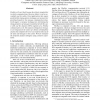Free Online Productivity Tools
i2Speak
i2Symbol
i2OCR
iTex2Img
iWeb2Print
iWeb2Shot
i2Type
iPdf2Split
iPdf2Merge
i2Bopomofo
i2Arabic
i2Style
i2Image
i2PDF
iLatex2Rtf
Sci2ools
ECRTS
2006
IEEE
2006
IEEE
Timing Analysis of the FlexRay Communication Protocol
FlexRay will very likely become the de-facto standard for in-vehicle communications. However, before it can be successfully used for safety-critical applications that require predictability, timing analysis techniques are necessary for providing bounds for the message communication times. In this paper, we propose techniques for determining the timing properties of messages transmitted in both the static (ST) and the dynamic (DYN) segments of a FlexRay communication cycle. The analysis techniques for messages are integrated in the context of a holistic schedulability analysis that computes the worst-case response times of all the tasks and messages in the system. We have evaluated the proposed analysis techniques using extensive experiments.
| Added | 11 Jun 2010 |
| Updated | 11 Jun 2010 |
| Type | Conference |
| Year | 2006 |
| Where | ECRTS |
| Authors | Traian Pop, Paul Pop, Petru Eles, Zebo Peng, Alexandru Andrei |
Comments (0)

